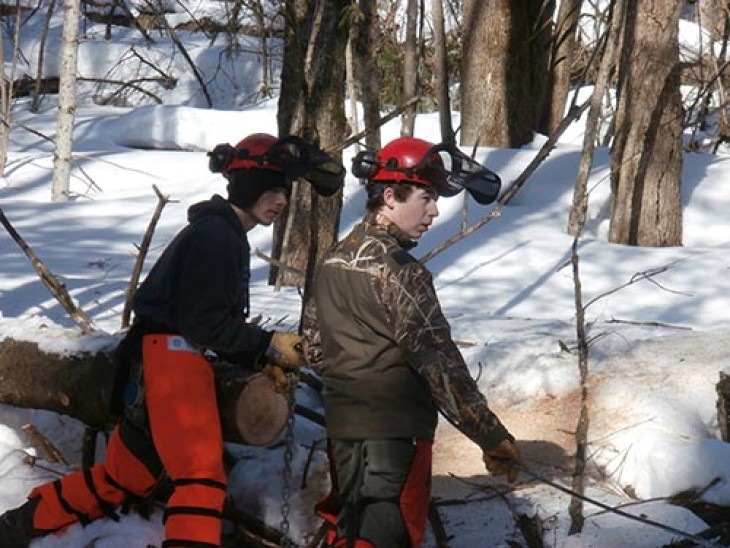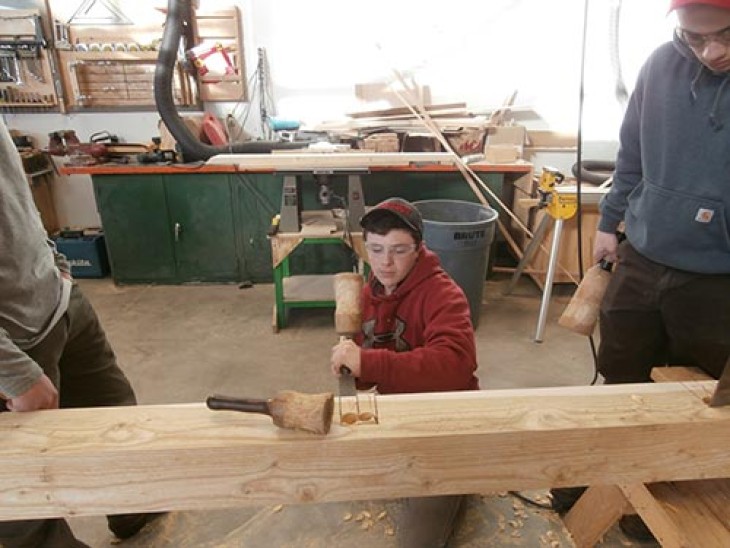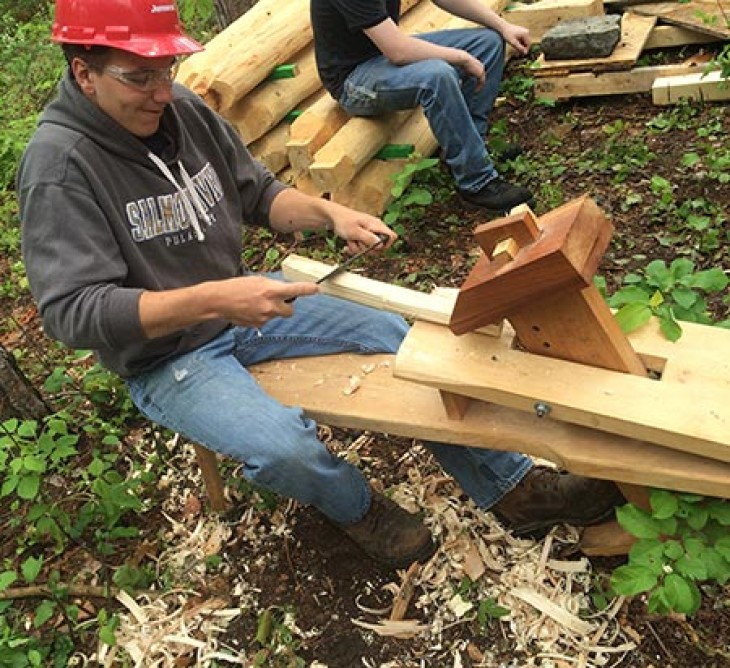
On a warm, sunny day last spring, just a few weeks before the end of the school year, professional timber framer Makaio Maher stood in a small clearing in a stand of red pine trees in Newport, Vermont, calling out instructions to two dozen high school students wearing white and red hardhats. “We need more pegs over here. Hold up, hold up – that side has to go in last. Take it up slowly.”
During the span of a single school day, a small cabin – 10 x 16 feet – took shape: sills laid atop granite corner slabs, one wall raised, then two and three and four, wooden pegs pounded to hold precisely cut pieces in place, loft joists fitted into beams, ceiling boards laid across purlins. Students from the North Country Career Center’s natural resources and building trades classes worked alongside their teachers and Maher to raise the frame, a replica of Henry David Thoreau’s cabin built 170 years earlier in a clearing 200 miles south of this one.
During the day, students from North Country Union High School English classes walked across the street from the high school to check on the cabin’s progress. These students had written grants to obtain funding for the cabin and corresponded with school and city officials to gain permission to build it. People walking along the recreation path that passes the cabin paused to watch before continuing toward Lake Memphremagog. Around midday, the school’s vice principal plucked a banjo in a shady spot nearby.
Learning About Walden…and Logging
In 1845, Henry David Thoreau famously absconded to the woods of Walden Pond to build a cabin and live a life of solitude two miles outside the town of Concord, Massachusetts. While Thoreau’s experiment was one of societal separation and self-reliance, the cabin erected last spring in Newport was a project of collaboration and community, of hands-on learning, and of creating something that will last beyond the schooling of the students involved.
“I had a vision a few years ago when I was teaching Walden,” said English teacher Ryan Anderson, who grew up near Concord and visited the replica of Thoreau’s cabin at Walden Pond as a student. “Seeing it first-hand really made me appreciate the simple life Thoreau lived for two years there. I wanted to bring that to my students, since I couldn’t bring the kids to Walden.”
Anderson contacted building trades teacher Tom Rooney, who was immediately onboard with the concept of replicating Thoreau’s cabin in Newport. Rooney secured school funding to enlist Maher, who owns Green Timber Works in nearby Glover, to work with his students. Natural resources instructor Sam Nijensohn set about repairing the old sawmill at the Career Center’s Harold J. Haynes Memorial Land Lab, a 60-acre working forest a few miles off campus.
“My class started from the tree, determining which trees to cut and why,” said Nijensohn.
After completing the Game of Logging chainsaw safety training, natural resources students took to the woods at the Land Lab, a lumber list in hand. They looked for trees showing signs of decline, as well as trees that needed to be thinned. The harvest included rot-resistant tamarack for use close to the ground, balsam fir, and a bit of poplar.
Each student in Nijensohn’s two classes – 18 altogether – selected and cut a tree for the project to come up with 1,000 board feet for the timber frame skeleton and another 1,000 board feet for the floor and sheathing. They worked together to get the trees out of the woods and organize the landing so they could safely and efficiently buck the logs into the appropriate lengths and mill the timber.
While Nijensohn’s students are all comfortable around a chainsaw and working outside – many of them sugar in the spring, hunt in the fall, and have put in countless hours cutting and splitting firewood at home – the Thoreau project allowed a chance for a practical experience in a working forest and the related planning that goes with that work.
“We definitely had to think ahead and know the next steps before we started,” said Isaiah Carbonneau, a junior in Nijensohn’s class last year, who is considering pursuing a career as a consulting forester after high school.
Throughout the process, students were able to choose aspects of the logging and milling work that most interested them, whether skidding logs to the landing, bucking them to length, or running the sawmill. And they had to work as a team in each step of the process.
“It’s pretty cool to know that we made every part of the cabin,” said Henry Delabruere, a junior last year, as he worked alongside other students to erect the cabin frame. “I feel like I learned a lot more doing this than in my other classes, being out in the woods and cutting the trees, skidding them out, making the measurements. It was really fun and hands-on – being able to run the equipment and work as a team.”
Framing and Fundraising
The Thoreau cabin project provided students a chance to develop a combination of skills. Nijensohn’s students learned to winch logs out of the woods properly, how to mill the wood to different sized cants, how to stack and sticker boards, and how to calculate board footage in tree form, log form, and board form. He pointed out that students also gained “basic employability” skills, such as learning to think ahead and to work as part of a team.
“The beauty of this project is that they don’t know how much they’re learning. They’re having fun and learning how much potential they have to do something like this in the future,” he said. “It’s been a great project.”
It also provided a perfect outlet for Maher to share his timber framing knowledge. As a member of the Timber Framing Guild, Maher said he endeavors to “keep timber framing alive and vibrant,” and working with students is an excellent way to do that.
“Timber framing was a lost art for a long time,” he said. “It’s great to introduce the kids to new tools. Most of them have used power tools, but putting a chisel and mallet in their hands is a brand new experience. I think using hand tools provides them with a greater sense of ownership. I like that kids get to see the old way of building – and see that hard work pays off.”
While Maher worked primarily with the building trades students to create the cabin’s frame – including a practice run over the winter when the frame was raised in the shop – the natural resources students, after supplying the raw materials, also had a hand in constructing the final product, and Anderson’s English classes made many of the pegs used in the cabin.
The English students also managed the administrative aspects of the project, writing a grant proposal to secure $1,000 of funding and obtaining permission from the Newport City Council to build the cabin on municipal property near Prouty Beach, so that it would accessible to students, other community members, and visitors. They selected a quote from Walden to be posted near the cabin: “If one advances confidently in the direction of one’s dreams, and endeavors to live the life which one has imagined, one will meet with a success unexpected in common hours…. In proportion as one simplifies one’s life, the laws of the universe will appear less complex, and solitude will not be solitude, nor poverty poverty, nor weakness weakness.”
Simple Lessons
The impetus for the project, Anderson said, was to demonstrate this message of simplicity from Walden, a place to reflect on nature and on the idea that “you don’t need lots of stuff to be happy.” To that end, this year Anderson’s students will design an outdoor classroom at the cabin, which he plans to use often. While Nijensohn’s students come to school in Carhartts and steel-toed boots ready to work outside, that connection to the outdoors is not always so acute with Anderson’s English students.
“This is going to give us a place to experience nature as we’re reading about it,” Anderson said. “I hope the lessons are clearer here.”
Nearly as soon as the cabin’s frame was up and the roof on last spring, Anderson took advantage of the outdoor space.
“I took my classes over to the cabin the day after it was constructed so they could experience writing about nature while surrounded by nature. I asked them to include sensory images gained firsthand in their journaling,” he said. “Shortly after dismissing them to the cafeteria for lunch, I witnessed a beautiful thing: four boys who had never opted to eat their lunches outside were sitting outside. I stored that in the win column of my mind and continued my day, a little more enthused.”





